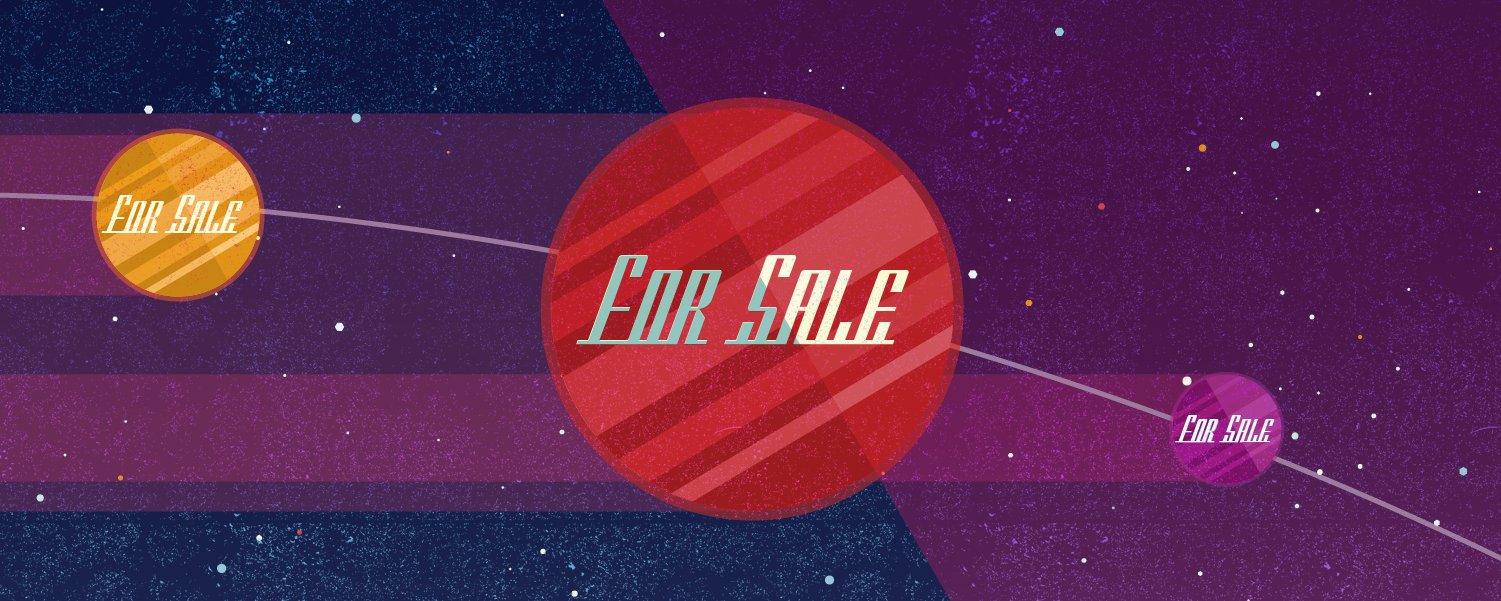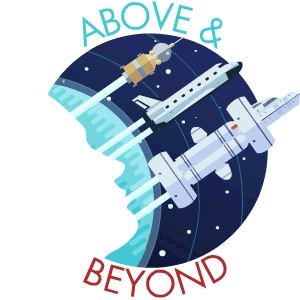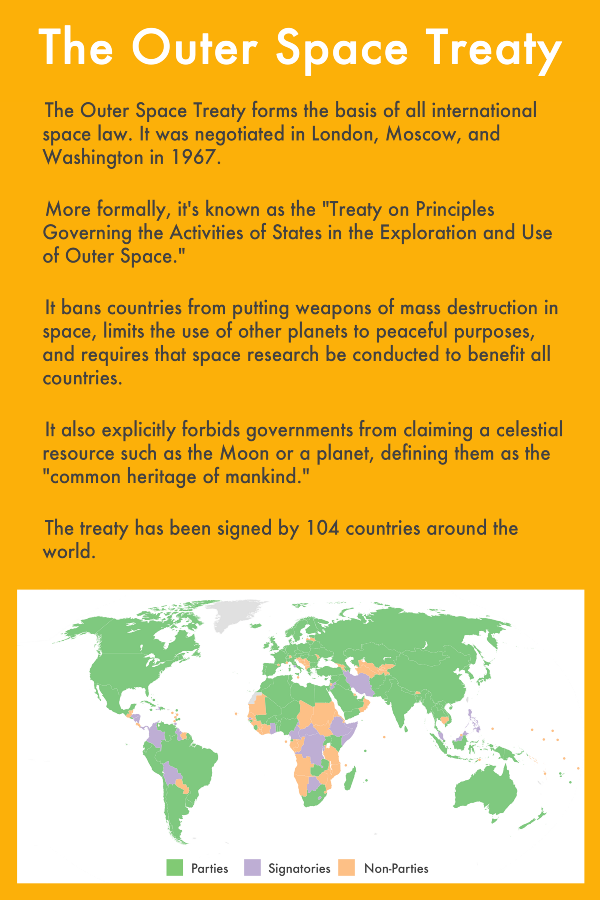

Dr. Philip Davies bought his first telescope in 2010, during the post-Christmas sales. Davies, a 43-year-old family doctor from Hampshire, England, positioned the Sky-Watcher Heritage 76 Mini Dobsonian on his desk and, the night before he left for a skiing holiday in Canada, caught his first glimpse of the planet Mars in its viewfinder.
At a bar in Vancouver the following week, Davies struck up a conversation with a 40-something ski bum named Cam. The conversation came around, as it sometimes does on barstools, to world peace. Davies mentioned his new telescope and, from there, it was a small, boozy hop to the more expansive subject of galactic harmony.
Cam, it turned out, had strong opinions on the issue. The Outer Space Treaty, which has since 1967 prevented the installation of weapons of mass destruction in the Earth’s orbit, on the Moon, or, in fact, on any other celestial body, was “toast,” Cam said. The OST, a treaty which more than a hundred countries have signed, is outdated at a time when schoolchildren are able to send cuddly toys into orbit. It is time for a new space treaty, Cam argued, to better govern who is able to send what into space. Then he issued his final, dramatic pronouncement: humanity is on the brink of a Third World War, one destined to be waged in outer space.
“I didn’t share his sense of disaster,” Davies recalled. “But I could see his point.”
When Davies returned home he began to read up on galactic law. “I was surprised to see that the 1967 treaty was indeed the cornerstone of current space law,” he said. Not only that, Davies perceived that it was riddled with legal loopholes and swathes of gray area when it comes to the ownership and stewardship of planetary bodies.

Articles I and II of the treaty provide some weak resistance to private claims for celestial appropriation, while Articles VI and VIII state that “activity” in space or “objects” sent into space are ultimately the responsibility of the relevant nation to which the individual or company operator belongs.
This has allowed space mavericks, as Davies calls them, to make plans to mine asteroids and, potentially, start colonizing celestial bodies illegally and with relative impunity.
Davies’s fear of maverick space settlers is not as outlandish as you might expect. In 1937, Arthur Dean Lindsay filed a deed at the Irwin County Courthouse in Ocilla, Georgia, declaring his ownership of “all of the property known as planets, islands-of-space, or other matter.” The local press declared Lindsay the “man who owns the universe,” an accolade that did little to steer his personal fortunes; later that year Lindsay declared bankruptcy.
A decade later, in December 1948, Chicagoan James T. Mangan declared himself the ruler of the Nation of Celestial Space. He began minting gold coins that he dubbed “celestons,” the official currency of space. Mangan managed to acquire a preposterously far-reaching title from the Cook County Recorder of Deeds establishing his ownership of “all space in all directions from the Earth.”
In 1952, Paul J. Donavan paid $1.50 to file a claim in the San Bernardino County Recorder’s Office to all rights to the Moon, the Sun, the stars, and atmosphere. Two days later, having realized that he had made a terrible omission, he returned to file an additional claim for the planets. Donavan’s claim went unnoticed by Mangan. When, in 1957, the Soviets launched Sputnik, Mangan declared it “an unprovoked trespassing into my territory.”
Some have even tried to claim ownership of planetary bodies where there is no hope of future habitation. In 2010, 55-year-old Spaniard Maria Angeles Duran staked a claim to the Sun (one that was, incredibly, upheld by a Spanish court) with the intention of charging anyone who used solar power to raise funds for Spain’s national pension fund. She began selling plots at a rate of €1 per square meter. Duran claims to have received 600 orders worth €1,200 ($1,317) before eBay closed the page for its violation of the auction site’s terms.
Scores of men have laid claim to the Moon. None have profited from the venture as much as former car salesman Dennis Hope who, in 1980, filed a claim of lunar ownership with the United Nations. Hope set up a company called the Lunar Embassy and began selling plots of land to members of the public. To date, he claims to have sold more than three million one-acre plots on the Moon for approximately $20 per acre. Dr Davies even owns a slice: A girlfriend bought him 10 lunar “sercas” in the mid-1990s. He still owns the certificate, which bears Hope’s signature.

With the issue of galactic ownership in disarray, and different countries signed up to varying codes of practice, Davies soon concluded that there is an increasing risk, if not of interstellar war, then at least of the gradual militarization of space. Something, he decided, needed to be done.
“I remember thinking that the celestial deeds salesmen had been pretty lazy,” said Davies. “Sure, they were making buckets of cash from selling these deeds, which are pretty much the equivalent of “‘World’s Best Dad’ certificates, but they hadn’t tried very hard to legally define their business.”
The legal criticism of Hope and his various franchisees around the world (the U.K. wing of The Lunar Embassy is MoonEstates.com; Angela Young, who runs the site from her home in Cornwall, told me the company has sold more than a million plots of lunar land in the United Kingdom and Ireland) is that nobody can make a statement of ownership without so-called “actions-of-ownership.” For example, when, in 1965, the U.S. Bureau of Land Management received a homestead claim for a lunar plot close to the Sea of Tranquility, a representative told the applicants that they would need to establish residence for at least six months in order to claim the site.
“I wondered if it was indeed possible to get closer to a legally entitled position for ownership of a celestial body,” Davies said. “At this point I didn’t think about where this was all taking me “¦ I just followed my nose.”
As Davies continued to research property law, a plan began to form in his mind. “I’d read Brownlie’s Principles of Public International Law, which equates Effective Occupation to factual possession.” In other words, Davies surmised, if he could find a way to squat Mars, he might be able to claim squatter’s rights.
At first Davies worried that he’d need to find a way to get to Mars to prove occupation. Then he read a provision that stated, when it comes to hard-to-reach areas of land on Earth, the Arctic, Antarctic, and so on, there is no requirement for a claimant to have actually visited the place. All one has to do is carry out exclusive and obvious governance activities or initiate early measures to make the land ready for future use.
That’s when Davies ordered his first laser.
A few months earlier, he had read an article in National Geographic titled “Making Mars the New Earth.” The piece argued that, if humans were able to cause a three-degree rise in the average temperature on the planet, they would trigger a greenhouse reaction that could make life on the planet viable. “All the planet needs to recapture its salad days is a gardener with a big budget,” wrote the article’s author.
“Using a bit of simple physics, taking into account laser specs, air mass, and our distance to Mars, I realized that, with a good aim, I could definitely smash laser photons into Mars. If these were focused on a patch of ground, they would cause bio-chemical reactions.”
Davies ordered four handheld lasers, a model that had been awarded a Guinness World Record for their unusual strength, from Hong Kong. When they arrived in March 2010, Davies fastened them to the telescope, found Mars in its viewfinder, and switched on the lasers.
On a tiny patch of ground, nearly 140 million miles from his home in Hampshire, a doctor had begun the work of terraforming Mars.

As the weeks went by, Davies added new features to his array of lasers. Using a sheet of cardboard and a metronome, he built a system to send a Morse Code message. It read: “I, Philip Davies, peacefully lay claim to possession of Planet Mars.”
He bought a new automatic telescope to track the planet so he wouldn’t have to follow it manually, and upgraded to 3,500 milliwatt Class 4 blue lasers (he now also uses an Android app to regulate the Morse Code messages).
While the lasers have a tight beam, over the huge distance from Earth to Mars the laser diverges such that its diameter is at least 30 times the diameter of Mars when it arrives. Even so, when Mars is at its closest to Earth (which happens once every two years) Davies has calculated that 122 photons per square meter reach the planet’s surface.
With the setup, he’s ensured that as long as Mars is visible from his house and is outside the operating hours of a local airport, the planet is being hit by one of his beams.
“I have been lasering Mars for six years now,” he said.
For the past 12 months, however, the focus of Davies’s work has moved into his legal claim, which a university professor of international law who wishes to remain anonymous believes is “industrious” and “genuinely competitive.”
Davies has been open about his scheme, registering the Twitter accounts @IClaimMars (sample tweet: “May was fab for Mars. Clear skies meant many nights using powerful lasers”) and @TrustMars, to tell the world about his project.
In early June, he wrote to a UN ambassador to explain his plan. He was passed on to Helen Mulvein, a UN senior legal counselor. Mulvein is pragmatic about Davies’s scheme. While the UN is trying hard to ensure a peaceful space, she said, the concept of celestial trusteeship by the UN was not something that was likely to be considered.
This polite, firm rejection has not dampened the doctor’s determination. (“I appreciate her straight and limited answers,” he said). Later this year Davies plans to go back to Mulvein with a few thousand co-claimants and a formal Application for First Registration to Land on Mars. “I will insist that she does a quick assessment of the legal merit of our case and forward it to the appropriate department,” he said. Six years is, he believes, a sufficient period of “exclusive possession” to bolster his claim.
Indeed, Davies’s solution technically satisfies the usual legal criteria for possession of remote land on Earth, but he remains uncertain as to whether or not the claim will be upheld. It may not matter. For Davies, unlike many of those who came before him, the goal has not been to profit from the stars, but rather to agitate a change in legislation. “The most likely positive outcome would be that our campaign irritates the Space Faring Nations into composing a new treaty which deals with space business, limits weapons, and prevents the sort of celestial land appropriation that we are attempting,” he said.
The difficulty will be in getting the UN to hear him out. Numbers matter. As such, he’s set up a website selling plots of Mars, a copy of Hope’s dubious lunar scheme. Why would someone want a piece of Mars over the Moon? Simple: Davies is drastically undercutting the competition. Ten acres of Mars costs just one cent.
“Look, my goal in all of this is not really the future ownership of Mars,” he said. “Rather, I want the UN to put Mars land in trust with UN Trusteeship. The reason for the website? I will have greater lobbying power with more fellow land-claimants.”
It’s an investment opportunity, too. All land claimants will become contingent beneficiaries of the Mars Trust. Should the OST be redrafted, the UN will have the preferential right to acquire all claims for a nominal fee of $1,000.
“OK,” said Davies, “the chance of the UN paying money to our land claimants is small. But we will have the strongest claim to a celestial body that’s ever been made.” He believes the claim is not only strong, but also enduring.
“It will present a significant hurdle when those wealthy space-faring individuals or companies start to insist on celestial acquisition.”


How We Get To Next was a magazine that explored the future of science, technology, and culture from 2014 to 2019. This article is part of our Above & Beyond section, which looks at our understanding of the universe beyond Earth. Click the logo to read more.
